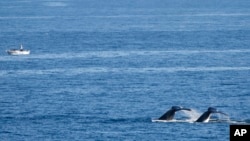Australia’s annual whale migration has begun with researchers documenting an unusually high number of humpbacks off the coast. Scientists say the surge is a sign that whale populations are recovering.
It’s one of nature’s epic migrations. Thousands of whales have begun their annual journey up eastern and western Australia to breeding grounds in the north. They can often be seen — and sometimes heard — from the shore.
Humpbacks that can grow to be the size of a bus and southern right whales were among several species that were once slaughtered for their oil, blubber and bones. Hunting was banned in Australia in 1978. Humpback numbers along the east coast have returned close to pre-whaling levels. But wildlife campaigners remain concerned about some southern right populations.
All whale species in Australia are protected under national environment laws as they recover from decades of exploitation.
Eastern Australia is known as the humpback highway. Whale watching from beaches and cliffs, as well as from boats has become a favorite pastime.
Information gathered by whale watchers, boat owners, photographers and tour operators is helping scientists learn more about these mysterious animals of the deep.
Vanessa Pirotta is a marine expert at Macquarie University. She told the Australian Broadcasting Corp. Tuesday that mass feeding in New South Wales state has researchers fascinated.
"We are trying to understand why is this happening," she said. "Is it the environmental conditions, is there something with climate change that is driving these mass feeding groups? So, there is a number of different things that we are looking at."
One regular visitor has become a celebrity. Migaloo is a rare white whale that was first spotted in 1991. The albino humpback has his own Twitter account, and was thought to have died. But last week a tourist flying over the Great Barrier Reef in Queensland filmed what appeared to be a white humpback swimming north. Researchers can’t be sure if Australia’s most famous whale has returned.
But thousands of other giant marine mammals have and are continuing to swim north, much to the delight of legions of whale watchers.
Between July and October, the whales and their young will begin their long journey back to Antarctic waters.






